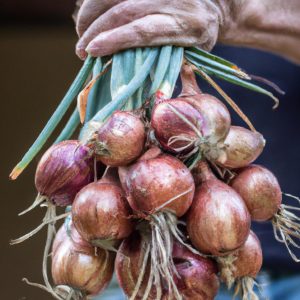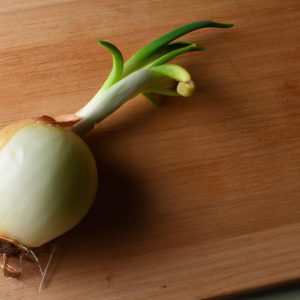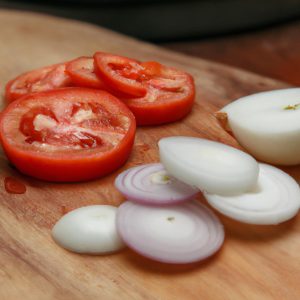As an onion ring lover, have you ever wondered how many calories are in your favorite snack? Onion rings are a popular side dish that can be found in almost every restaurant. However, they are often deep-fried and loaded with calories, which can be a concern for those watching their weight.
Knowing the calorie count of onion rings is essential for making informed decisions about your diet. In this article, we will take a closer look at how many calories are in an onion ring and explore the health benefits and risks of consuming them. We will also provide some low-calorie alternatives to onion rings, so you can still enjoy a tasty snack without compromising your health.
So, let’s dive in and explore the world of onion rings and their calorie count!
What is an Onion Ring?

Onion rings are a popular snack made from sliced onions that are battered and deep-fried. They are often served as a side dish in restaurants or as a snack at home. Onion rings can be made from different types of onions, and there are various ways to prepare them, resulting in different types of onion rings.
A. Definition of Onion Ring
An onion ring is a sliced onion that is dipped in batter and deep-fried until crispy. It is a popular snack that is often served in restaurants or as a side dish with a meal. The size and thickness of the onion rings can vary, depending on personal preference and the recipe used.
B. Types of Onion Rings
There are different types of onion rings, including beer-battered onion rings, breaded onion rings, and tempura onion rings. Beer-battered onion rings are made by dipping the onion rings in a batter made with beer, flour, and spices. Breaded onion rings are made by coating the onion rings in bread crumbs before frying them. Tempura onion rings are made with a batter made from flour, water, and egg, and they are often lighter and less greasy than other types of onion rings.
C. Ingredients Used in Making Onion Rings
The ingredients used in making onion rings can vary, depending on the recipe. Generally, onion rings are made with sliced onions, flour, eggs, milk, and spices. The batter can also include beer, baking powder, or cornstarch. Some recipes call for the use of breadcrumbs or panko crumbs to coat the onion rings before frying them. The type of oil used for frying can also vary, with vegetable oil or canola oil being the most commonly used.
How Many Calories are in an Onion Ring?

If you’re watching your calorie intake, knowing the calorie count of onion rings is crucial. Here’s a breakdown of the calorie content of onion rings and the factors that affect it.
A. Explanation of calorie counting
Calories are a measure of the energy content of food. The number of calories in a particular food item is determined by the amount of energy it provides when consumed. To calculate the calorie count of onion rings, we need to consider several factors, including the serving size, cooking method, and ingredients used.
B. Standard serving size of onion rings
The standard serving size for onion rings varies depending on the restaurant or recipe. However, a typical serving size is around 6-8 onion rings. Keep in mind that the calorie count will increase if you consume a larger serving size.
C. Average calorie count of onion rings
The average calorie count of onion rings is around 150-200 calories per serving. However, this can vary depending on the size of the onion rings, the type of batter used, and the cooking method. Deep-fried onion rings tend to be higher in calories than baked or grilled onion rings.
D. Factors that affect the calorie count of onion rings
Several factors can affect the calorie count of onion rings, including the type of onion used, the type of batter used, the cooking method, and the seasoning. For example, onion rings coated in a thick batter and deep-fried will have a higher calorie count than onion rings coated in a thin batter and baked or grilled.
Now that you know the calorie count of onion rings and the factors that affect it, you can make informed decisions about your diet. In the next section, we will explore the health benefits and risks of consuming onion rings.
Health Benefits and Risks of Onion Rings

Onions are a low-calorie vegetable that is packed with nutrients and health benefits. They are rich in vitamins, minerals, and antioxidants, which can help reduce the risk of chronic diseases such as heart disease, diabetes, and cancer.
Nutritional Value of Onions
Onions are an excellent source of vitamin C, which is essential for maintaining a healthy immune system. They also contain vitamin B6, folate, and potassium, which are essential for healthy blood pressure and brain function. Onions are also rich in antioxidants, which can help protect the body from oxidative stress and inflammation.
Health Benefits of Onions
Onions have numerous health benefits, including reducing the risk of heart disease, lowering cholesterol levels, and improving blood sugar control. They also have antibacterial properties and can help boost the immune system, making them an excellent addition to any diet.
Risks of Consuming Too Many Onion Rings
While onions are a healthy vegetable, onion rings are often deep-fried and loaded with calories and unhealthy fats. Consuming too many onion rings can lead to weight gain, high cholesterol levels, and an increased risk of heart disease. It is essential to consume onion rings in moderation and opt for healthier alternatives whenever possible.
Alternatives to Onion Rings
If you’re looking for a healthier alternative to traditional onion rings, there are plenty of options available. Here are some low-calorie alternatives to onion rings that you can try:
Low-Calorie Alternatives to Onion Rings
- Baked Onion Rings – Instead of deep-frying your onion rings, try baking them in the oven for a healthier option. This will reduce the amount of oil used and, in turn, the calorie count.
- Zucchini Fries – Zucchini fries are a great low-calorie alternative to onion rings. They are crispy and delicious, but much healthier than traditional onion rings.
- Carrot Fries – Carrots are a great source of vitamins and minerals, making them a nutritious option for a snack. Cut them into thin strips and bake them in the oven for a healthy and delicious alternative to onion rings.
Nutritious Alternatives to Onion Rings
- Sweet Potato Rings – Sweet potatoes are packed with nutrients and are a great source of fiber. Cut them into rings and bake them in the oven for a nutritious and delicious alternative to onion rings.
- Avocado Fries – Avocados are high in healthy fats and are a great source of fiber and vitamins. Slice them into wedges and coat them in breadcrumbs before baking them in the oven for a nutritious alternative to onion rings.
Healthy Ways of Preparing Onion Rings
- Use Whole-Grain Flour – Instead of using white flour to coat your onion rings, try using whole-grain flour for a healthier option.
- Use Olive Oil – Olive oil is a healthier alternative to vegetable oil, which is often used to deep-fry onion rings. Brush some olive oil onto your onion rings before baking them in the oven for a healthier option.
By incorporating these alternatives to onion rings into your diet, you can enjoy a tasty snack while still maintaining a healthy lifestyle.
Conclusion
In conclusion, knowing the calorie count of onion rings is essential for maintaining a healthy diet. While onion rings can be a delicious snack, they are often deep-fried and loaded with calories. However, there are alternatives to traditional onion rings that are lower in calories and more nutritious.
In this article, we have explored the calorie count of onion rings, their health benefits and risks, and provided some low-calorie alternatives to enjoy. By incorporating healthy options into your diet, you can still indulge in your favorite snacks without compromising your health.
Remember, moderation is key when it comes to consuming high-calorie foods like onion rings. So, next time you’re craving a delicious snack, make an informed decision and choose an option that works best for you.
Thank you for reading, and we hope you found this article informative. For more information on onions and healthy eating, visit onionfacts.com.







